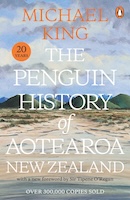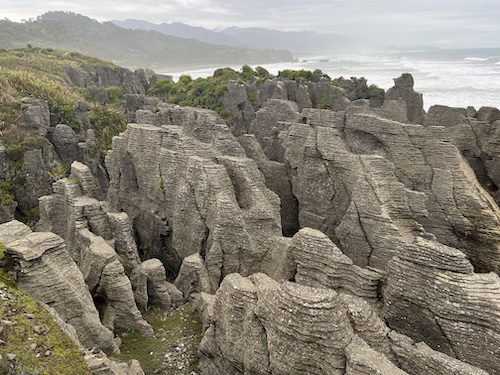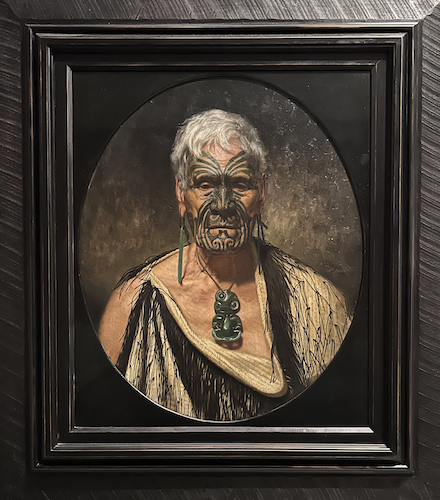kuniga.me > Books > The Penguin History of Aotearoa
The Penguin History of Aotearoa

This is a comprehensive book about New Zealand, from the early Maōri settlement from East Polynesia to recent years. Overall a very informative book and easy to read.
Chapter 1
Eruption of Taupo volcano was possibly described by Romans and Chinese because it affected far away lands.
Chapter 2 - Seeds of Rangiātea
This chapter mentions a theory that suggests that Kumara (sweet potato), a staple from Polynesias, came from South America (likely Peru) and that’s evidence of pre-European contact between Polynesians and Natives from South American.
Chapter 4 - Landfall
The East Polynesias that arrived at Chatham Islands became culturally different from the Maōri in New Zealand and were called Moriori.
Chapter 7 - Distance Perforated
This chapter describes the first European incursions in the area. In particular, Abel Tasman from the Dutch VOC landed just north of Punakaiki (a famous tourist spot today in South island) but apparently he didn’t spend much time inland. Tasman also names places like the Tasman Sea and the island of Tasmania.

The West coast of Australia used to be called New Holland.
Chapter 8 - The Arrival of Europe
Mentions the visit from other Europeans, Captain Cook, Jean du Surville and George Vancouver. Cook was exploring other Polynesian islands and had with him an interpreter from Tahiti that could communicate with the Maōri. Vancouver also “discovered” the Chatham Islands and gave its current name.
An observation made is that Maōri were considered more violent and organized than Australian aborigines in the eyes of Europeans so this delayed colonization, which was good for the natives since with time Europeans became more “enlightened” and humanistic.
Chapter 9 - Maori Engage the World
This chapter focuses on the collaboration between Maōri and Europeans on extrativist endeavors, including sealing, whaling, extracting flax and timber. At this time Europeans were still based largely on the East coast of Austrlia.
Chapter 10 - Gods and guns
Gods: Describes early missionary work, mainly from the English Church with some Catholic French.
Guns: Refers to the fact that Europeans started providing guns to Maōri and this changed the warfare. Tribes with guns had tremendous advantage, so they either obliterated competing unarmed tribes or an equilibrium between armed ones happened.
Chapter 11 - A treaty
This focuses on the treaty of Waitangi which was vague and the Maōri translation was poor. It was largely used by Europeans to get land from the Maōri tribes.
The treaty was signed by some Maōri chiefs, many not understanding the extension of the treaty, also since Maōri were not a unified entity, there’s debate on whether it had validity across the entire islands.
Chapter 13 - Tangata Wehua Respond
This describes the Northern Wars between Maōri and settlers in the North island.
Chapter 14 - New Settlers Take Control
The Otago gold rush in the 1860’s the attracted a lot of immigrants to the South island, including Chinese. This increase the wealth of the Scottish settlement of Dunedin (the Gaelic name of Edinburgh). This led to outcomes such as it creating the first university in the country, the University of Otago.
Chapter 15 - A time of Turbulence
The Maōris started believing that they could achieve unity by selecting a king, in the models of the British monarchy. They chose Te Wherowhero (aka Pōtatau) and the movement supporting him called Kīngitanga.
Pōtatau was the leader of the Waikato Maōri. The European settlers saw the Kīngitanga movement as a threat, after some disputes over land, the conflicts escalated into a war, with Europeans and their allies attacking forts (pās) within the Waikato region (the region between Aukland and Hamilton).
There was also another set of conflicts in the Taranaki region. These wars and others are part of the called New Zealand Wars, the second and last armed conflict between Maōri and Europeans.

Chapter 16 - A functioning nation?
New Zealand abandoned provincial government and opted to a centralized one, unlike the US for example.
There was a depression in the decade of 1980. The technology of refrigeration saved New Zealand’s economy because they could now export meat (lamb) and dairy back to England (its main trade partner).
Chapter 18 - Party Politics Begin
Describes the rise of the Liberal party which led to a lot of progressive reforms such as land, labor and public health reforms. Women’s suffrage also happened during this time but apparently this was not supported by the party.
I learned that Ernest Rutherford was from New Zealand.
Chapter 19 - Baptism of Blood
Covers the participation of New Zealand in World War I. Western Samoa (now just Samoa) was under German occupation and New Zealand took over.
They formed an alliance with Australians called the ANZAC (Australia and New Zealand Army Corps). This expeditionary fought against the Ottoman empire in Turkey, at Gallipoli. The casualties were very high and this became memorialized as the ANZAC day (April 25th), a national holiday.
Chapter 22 - Depression and recovery
Covers the great depression of 1929. One interesting observation made is that the depression years caused people to look up socialist ideals.
Chapter 23 - Conformity and non-conformity
Focuses on discrimination by male European descendants towards other minorities, including Chinese, Māori, women, homosexuals.
Chapter 24 - At war again
Covers New Zealand’s participation in World War II, in particular the battles in Greece and Crete where they failed to repel the Germans. Then the North African campaign (Egypt and Lybia) against Erwin Rommel and the Italians.
Chapter 25 - Cracks in the Plinth
Mentions Edmund Hillary, from Auckland, as the first person known to have climbed Mount Everest.
Claims that the Korean war created a boom for New Zealand wool, possibly for the soldier uniforms.
Chapter 26 - Land under pressure
Focuses on the increase care about the environment, focusing in particular on the Save Manapouri campaign.
Chapter 27 A revolution begun
Lyndon B Johnson was the first president in office to visit New Zealand. England joined the European Community (which eventually became the EU) in 1973. This required New Zealand to diversify its trading outside of Europe.
Chapter 28 - Return of Mana Maori
Rapid Māori urbanization due to farming not being able to sustain a growing population. Clash of cultures in urban centers (before these two populations had largely lived separated).
Chapter 29 - A Revolution Confirmed
Reagan insisted New Zealand to be left out of ANZUS (Australia, New Zealand and United States Security Treaty), because of their refusal to let nuclear vessels in.
Treaty of Waitangi was reinterpreted to benefit Māori, for example by allow them to win settlements.
Chapter 30 - Configurations old and new
Mentions that European descendants in New Zealand (known as Pākehās) want some form of recognition of their own culture as distinct from that of Europe, in face of the Māori cultural renaissance.